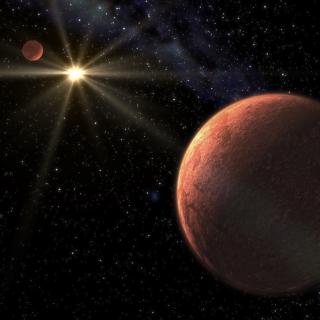Bibcode
Baroch, D.; Morales, J. C.; Ribas, I.; Tal-Or, L.; Zechmeister, M.; Reiners, A.; Caballero, J. A.; Quirrenbach, A.; Amado, P. J.; Dreizler, S.; Lalitha, S.; Jeffers, S. V.; Lafarga, M.; Béjar, V. J. S.; Colomé, J.; Cortés-Contreras, M.; Díez-Alonso, E.; Galadí-Enríquez, D.; Guenther, E. W.; Hagen, H.-J.; Henning, T.; Herrero, E.; Kürster, M.; Montes, D.; Nagel, E.; Passegger, V. M.; Perger, M.; Rosich, A.; Schweitzer, A.; Seifert, W.
Bibliographical reference
Astronomy and Astrophysics, Volume 619, id.A32, 17 pp.
Advertised on:
11
2018
Journal
Citations
46
Refereed citations
40
Description
Context. The CARMENES spectrograph is surveying ˜300 M dwarf stars
in search for exoplanets. Among the target stars, spectroscopic binary
systems have been discovered, which can be used to measure fundamental
properties of stars. Aims: Using spectroscopic observations, we
determine the orbital and physical properties of nine new double-line
spectroscopic binary systems by analysing their radial velocity curves.
Methods: We use two-dimensional cross-correlation techniques to
derive the radial velocities of the targets, which are then employed to
determine the orbital properties. Photometric data from the literature
are also analysed to search for possible eclipses and to measure stellar
variability, which can yield rotation periods. Results: Out of
the 342 stars selected for the CARMENES survey, 9 have been found to be
double-line spectroscopic binaries, with periods ranging from 1.13 to
˜8000 days and orbits with eccentricities up to 0.54. We provide
empirical orbital properties and minimum masses for the sample of
spectroscopic binaries. Absolute masses are also estimated from
mass-luminosity calibrations, ranging between ˜0.1 and ˜0.6
M⊙. Conclusions: These new binary systems increase
the number of double-line M dwarf binary systems with known orbital
parameters by 15%, and they have lower mass ratios on average.
Related projects

Very Low Mass Stars, Brown Dwarfs and Planets
Our goal is to study the processes that lead to the formation of low mass stars, brown dwarfs and planets and to characterize the physical properties of these objects in various evolutionary stages. Low mass stars and brown dwarfs are likely the most numerous type of objects in our Galaxy but due to their low intrinsic luminosity they are not so
Rafael
Rebolo López

Exoplanets and Astrobiology
The search for life in the universe has been driven by recent discoveries of planets around other stars (known as exoplanets), becoming one of the most active fields in modern astrophysics. The growing number of new exoplanets discovered in recent years and the recent advance on the study of their atmospheres are not only providing new valuable
Enric
Pallé Bago